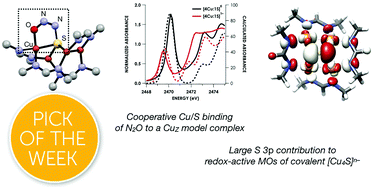当前位置:
X-MOL 学术
›
Chem. Sci.
›
论文详情
Our official English website, www.x-mol.net, welcomes your
feedback! (Note: you will need to create a separate account there.)
Probing the electronic and mechanistic roles of the μ4-sulfur atom in a synthetic CuZ model system
Chemical Science ( IF 7.6 ) Pub Date : 2020/02/17 , DOI: 10.1039/c9sc06251c Suresh C Rathnayaka 1 , Shahidul M Islam 1 , Ida M DiMucci 2 , Samantha N MacMillan 2 , Kyle M Lancaster 2 , Neal P Mankad 1
Chemical Science ( IF 7.6 ) Pub Date : 2020/02/17 , DOI: 10.1039/c9sc06251c Suresh C Rathnayaka 1 , Shahidul M Islam 1 , Ida M DiMucci 2 , Samantha N MacMillan 2 , Kyle M Lancaster 2 , Neal P Mankad 1
Affiliation

|
Nitrous oxide (N2O) contributes significantly to ozone layer depletion and is a potent greenhouse agent, motivating interest in the chemical details of biological N2O fixation by nitrous oxide reductase (N2OR) during bacterial denitrification. In this study, we report a combined experimental/computational study of a synthetic [4Cu:1S] cluster supported by N-donor ligands that can be considered the closest structural and functional mimic of the CuZ catalytic site in N2OR reported to date. Quantitative N2 measurements during synthetic N2O reduction were used to determine reaction stoichiometry, which in turn was used as the basis for density functional theory (DFT) modeling of hypothetical reaction intermediates. The mechanism for N2O reduction emerging from this computational modeling involves cooperative activation of N2O across a Cu/S cluster edge. Direct interaction of the μ4-S ligand with the N2O substrate during coordination and N–O bond cleavage represents an unconventional mechanistic paradigm to be considered for the chemistry of CuZ and related metal–sulfur clusters. Consistent with hypothetical participation of the μ4-S unit in two-electron reduction of N2O, Cu K-edge and S K-edge X-ray absorption spectroscopy (XAS) reveal a high degree of participation by the μ4-S in redox changes, with approximately 21% S 3p contribution to the redox-active molecular orbital in the highly covalent [4Cu:1S] core, compared to approximately 14% Cu 3d contribution per copper. The XAS data included in this study represent the first spectroscopic interrogation of multiple redox levels of a [4Cu:1S] cluster and show high fidelity to the biological CuZ site.
中文翻译:

探讨合成 CuZ 模型系统中 μ4-硫原子的电子和机械作用
一氧化二氮 (N 2 O) 对臭氧层消耗有显着贡献,并且是一种有效的温室气体,激发了人们对细菌反硝化过程中一氧化二氮还原酶 (N 2 OR) 固定生物 N 2 O 的化学细节的兴趣。在这项研究中,我们报告了由 N 供体配体支持的合成 [4Cu:1S] 簇的实验/计算联合研究,该簇可以被认为是迄今为止报道的 N 2 OR 中 Cu Z催化位点最接近的结构和功能模拟。合成 N 2 O 还原过程中的定量 N 2测量用于确定反应化学计量,进而用作假设反应中间体的密度泛函理论 (DFT) 建模的基础。该计算模型中出现的 N 2 O 还原机制涉及跨 Cu/S 簇边缘的 N 2 O 协同激活。 μ 4 -S 配体与 N 2 O 底物在配位和 N-O 键断裂过程中的直接相互作用代表了 Cu Z和相关金属硫簇化学的非常规机械范式。 与 μ 4 -S 单元参与 N 2 O 的双电子还原的假设一致,Cu K 边和 S K 边 X 射线吸收光谱 (XAS) 显示 μ 4 -S 的高度参与在氧化还原变化中,高共价 [4Cu:1S] 核中氧化还原活性分子轨道的 S 3p 贡献约为 21%,而每个铜的 Cu 3d 贡献约为 14%。本研究中包含的 XAS 数据代表了对 [4Cu:1S] 簇的多个氧化还原水平的首次光谱询问,并显示出对生物 Cu Z位点的高保真度。
更新日期:2020-04-01
中文翻译:

探讨合成 CuZ 模型系统中 μ4-硫原子的电子和机械作用
一氧化二氮 (N 2 O) 对臭氧层消耗有显着贡献,并且是一种有效的温室气体,激发了人们对细菌反硝化过程中一氧化二氮还原酶 (N 2 OR) 固定生物 N 2 O 的化学细节的兴趣。在这项研究中,我们报告了由 N 供体配体支持的合成 [4Cu:1S] 簇的实验/计算联合研究,该簇可以被认为是迄今为止报道的 N 2 OR 中 Cu Z催化位点最接近的结构和功能模拟。合成 N 2 O 还原过程中的定量 N 2测量用于确定反应化学计量,进而用作假设反应中间体的密度泛函理论 (DFT) 建模的基础。该计算模型中出现的 N 2 O 还原机制涉及跨 Cu/S 簇边缘的 N 2 O 协同激活。 μ 4 -S 配体与 N 2 O 底物在配位和 N-O 键断裂过程中的直接相互作用代表了 Cu Z和相关金属硫簇化学的非常规机械范式。 与 μ 4 -S 单元参与 N 2 O 的双电子还原的假设一致,Cu K 边和 S K 边 X 射线吸收光谱 (XAS) 显示 μ 4 -S 的高度参与在氧化还原变化中,高共价 [4Cu:1S] 核中氧化还原活性分子轨道的 S 3p 贡献约为 21%,而每个铜的 Cu 3d 贡献约为 14%。本研究中包含的 XAS 数据代表了对 [4Cu:1S] 簇的多个氧化还原水平的首次光谱询问,并显示出对生物 Cu Z位点的高保真度。











































 京公网安备 11010802027423号
京公网安备 11010802027423号